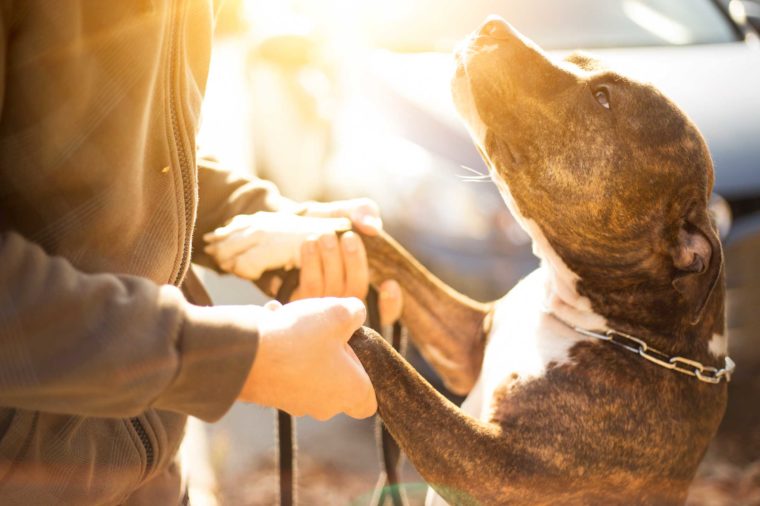Man’s most trusting companion?
Let’s be honest: You probably love your dog more than you love some humans. You spend most of your spare time exercising or cuddling with him. You talk to her just like you’d talk to your human best friend—freely without fear of being judged. The level of love and trust you feel toward your pet is no different than what you feel toward any other family member. But is the feeling mutual? Here’s how to tell if your dog trusts you.
He learns your routines
Trust is perceived differently for humans and animals, says Vicki Stevens, senior marketing communications manager for companion animals at the Humane Society of the United States. Pets rely on routines to feel normalcy and have comfortable, happy lives. So the best way to build a relationship with your dog is to make these routines positive interactions.
If you feed him every day at 8 a.m. or take him for a walk as soon as you get home from work, he becomes conditioned to expect those things at those designated times. Once a routine is set, he’ll be on time to get that food or that walk, and he’ll trust you’ll hold up your end of the arrangement.
Her eyes say it all

A recent study from the University of Japan found that when dogs and their owners stared into each other’s eyes during a 30-minute period, both of their oxytocin levels increased. Oxytocin has also been called the love hormone and the cuddle hormone (see where we’re going with this?). It’s used to help mothers bond with their babies and it spikes when we’re around someone we love and trust. Lead scientist Takefumi Kikusui believes that this result could mean that the dogs were trying to form bonds with their owners—definitely a sign of trust.
Kenny Lamberti, acting vice president of companion animals at H.S.U.S., cautions that since dogs are individuals like humans, staring doesn’t necessarily mean the same thing every time it happens. Body language and environment should be taken into consideration, too.
He sleeps in your room
“Typically, dogs sleep in a place that they are comfortable,” Lamberti writes, “so sleeping in an owner’s room could certainly be an indication of comfort.” He also noted that environment can affect whether your pooch settles down in your room or on your bed. However, you may want to carefully weigh your pros and cons before you invite him into your bed.
She doesn’t see you angry often
It’s normal to get frustrated at your dog, but a study from Brigham Young University suggested that she can read your emotions, and she’s less likely to trust you when you’re in a bad mood. Researchers tracked how dogs reacted when they saw humans point to a hidden reward silently, and then using positive or negative facial and vocal expressions. When dogs saw the negative behaviors (frowning, furrowed brow, and a harsh voice), they were less willing to search for the treat.
He steals your shoes
It may be annoying when your dog takes your favorite pair of shoes or scarf, but he may be doing so for an endearing reason. While this behavior may not solely be based on trust (your dog may just know that you pay attention to him when he takes certain objects), Jessica Lockhart, animal behavior director for the ASPCA Adoption Center, says your pooch could be comforted by having some connection to you, especially while you’re away. What better connection than something that smells just like you?
She wags her tail a certain way

It’s a common misconception that any ol’ tail wag means your pooch is happy. A group of Italian researchers concluded in a 2007 study that the direction in which a dog wags her tail can reveal the emotions she’s feeling. Specifically, right-leaning wagging is a sign of positive emotions, and left-leaning wagging indicates negative ones. So if your dog wags her tail to the right when she sees you, you are officially on her list of favorite things in the world.
You understand his body language
Some dogs are naturally more relaxed around their owners, while others are more enthusiastic and jumpy. It varies depending on the dog, but if that behavior changes, that’s when you know something is wrong. “If you want a dog to trust you, it’s important to learn about dog body language so that you can read when your dog wants physical interaction and when he does not,” Lockhart says. She recommends practicing “consent petting.” Only pet a dog if he doesn’t move away when you approach him. If he approaches you, pet him for three second, then look at his reaction. If he leans in or bops your hand, keep on petting. If he licks his lips quickly, turns his head away, or yawns, she’s had enough. “The more you listen to what your dog is telling you with their body,” Lockhart says, “the more trust you will build with your dog.”
She follows your lead
The results of a 2013 study showed that dogs that have a strong bond with their owners behave similarly to the bond human children have with their parents. They look to their owners when they’re uncertain. They’re more likely to explore new places with their owners, as opposed to going alone or with a stranger. They even copy to their owners emotions to a degree, showing anxiety when the owners are anxious and calm when the owners are calm. Lockhart cautions that this may or may not be specifically a sign of trust, but it definitely demonstrates familiarity and comfort.












